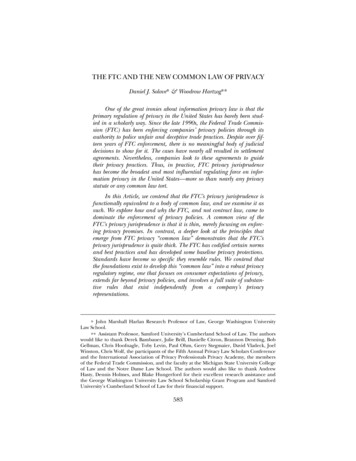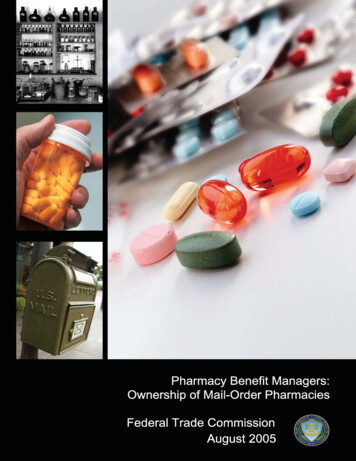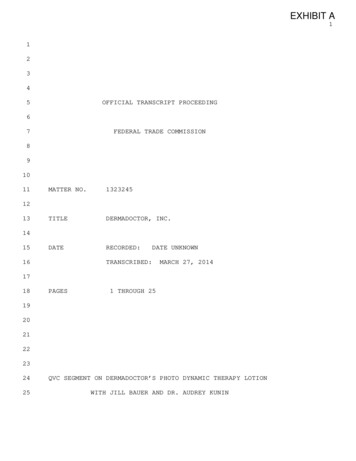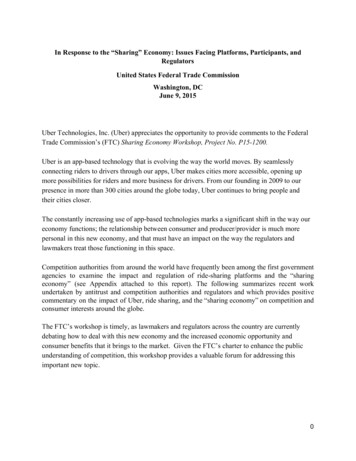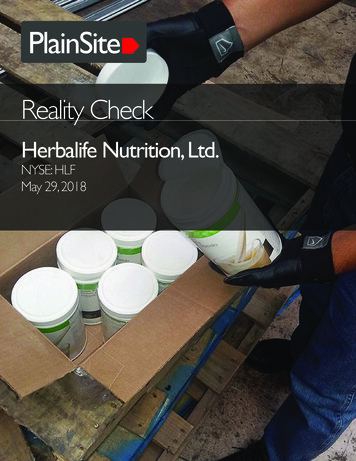
Transcription
Case 1:14-cv-00851 Document 1-2 Filed 09/08/14 Page 1 of 19Case No. 1:14-cv:00851EXHIBIT A
Case 1:14-cv-00851 Document 1-2 Filed 09/08/14 Page 2 of 19Case No. 1:14-cv:00851Diabetes, Metabolic Syndrome and Obesity: Targets and TherapyDovepressopen access to scientific and medical researchO r i g i n al R e s e a r c hOpen Access Full Text ArticleRandomized, double-blind, placebo-controlled,linear dose, crossover study to evaluate theefficacy and safety of a green coffee bean extractin overweight subjectsThis article was published in the following Dove Press journal:Diabetes, Metabolic Syndrome and Obesity: Targets and Therapy17 January 2012Number of times this article has been viewedJoe A Vinson 1Bryan R Burnham 2Mysore V Nagendran 3Chemistry Department, 2PsychologyDepartment, University of Scranton,Scranton, PA, USA; 3Health SciencesClinic, Bangalore, India1Background: Adult weight gain and obesity have become worldwide problems. Issues ofcost and potential side effects of prescription weight loss drugs have led overweight and obeseadults to try nutraceuticals that may aid weight loss. One promising nutraceutical is green coffee extract, which contains high concentrations of chlorogenic acids that are known to havehealth benefits and to influence glucose and fat metabolism. A 22-week crossover study wasconducted to examine the efficacy and safety of a commercial green coffee extract productGCA at reducing weight and body mass in 16 overweight adults.Methods: Subjects received high-dose GCA (1050 mg), low-dose GCA (700 mg), or placeboin separate six-week treatment periods followed by two-week washout periods to reduce anyinfluence of preceding treatment. Treatments were counterbalanced between subjects. Primarymeasurements were body weight, body mass index, and percent body fat. Heart rate and bloodpressure were also measured.Results: Significant reductions were observed in body weight ( 8.04 2.31 kg), body mass index( 2.92 0.85 kg/m2), and percent body fat ( 4.44% 2.00%), as well as a small decrease inheart rate ( 2.56 2.85 beats per minute), but with no significant changes to diet over the courseof the study. Importantly, the decreases occurred when subjects were taking GCA. Body massindex for six subjects shifted from preobesity to the normal weight range (,25.00 kg/m2).Conclusion: The results are consistent with human and animal studies and a meta-analysisof the efficacy of green coffee extract in weight loss. The results suggest that GCA may be aneffective nutraceutical in reducing weight in preobese adults, and may be an inexpensive meansof preventing obesity in overweight adults.Keywords: green coffee bean extract, chlorogenic acid, body mass index, weight loss, bodyfat mass, blood pressure, heart rateIntroductionCorrespondence: MV NagendranD 503, Adarsh Residency, 47th Cross,8th Block, Jayanagar, Bangalore,India 560042Tel 91 98 4501 0682Fax 91 80 2656 3995Email drmvnagendran@gmail.comsubmit your manuscript 7/DMSO.S27665The World Health Organization predicts there will be 2.3 billion overweight adultsin the world by 2015, and more than 700 million of them will be obese. Worldwideobesity has more than doubled since 1980. In 2008, 1.5 billion adults, 20 years of ageand older, were overweight. Of these, over 200 million men and nearly 300 millionwomen were obese. Over 65% of the world population lives in countries whereoverweight and obesity kills more people than underweight.1 With the high cost ofprescription weight loss drugs and the fear of side effects, the general public is turningto nutraceuticals. The estimated global market for 2014 is over 350 billion US dollars,as published by Market Research News.2Diabetes, Metabolic Syndrome and Obesity: Targets and Therapy 2012:5 21–27 2012 Vinson et al, publisher and licensee Dove Medical Press Ltd. This is an Open Access articlewhich permits unrestricted noncommercial use, provided the original work is properly cited.21Ex. A
Case 1:14-cv-00851 Document 1-2 Filed 09/08/14 Page 3 of 19Case No. 1:14-cv:00851DovepressVinson et alAt the present time, there is only one nonprescriptionnutraceutical product that is currently under investigation(Pharmachem Laboratory, Phase II) and is approved by theUS Food and Drug Administration, with a qualified healthclaim for assistance in weight control and a structure-functionclaim for its mechanism, which is that it blocks starch absorption by means of an α-amylase inhibitor.3,4 Coffee is of interest as a possible nutraceutical for weight loss because caffeineis a well known stimulant, and an epidemiology study foundthat coffee consumption resulted in less weight gain in obesemen over an 18-month period.5 A polysaccharide ingredientin coffee caused weight reduction when added to the diet ofobese men but was not effective for women.6 Freeze-driedcoffee was found to cause weight loss when given to rats.It also increased antioxidant enzymes.7 Caffeine, the majorstimulant in coffee, has been linked to weight loss and toreduction in the risk of metabolic syndrome.8 Existing butlimited evidence suggests that substituting coffee for energycontaining soft drinks may facilitate weight management.9Several epidemiological investigations have found thatcoffee consumption reduces the risk of type 2 diabetes, andone of the mechanisms proposed for this benefit is that coffeeconsumption is inversely associated with weight gain.10 Thepurpose of this study was to investigate the efficacy of ahigh chlorogenic acid green coffee bean extract in reducingweight, body mass, and body fat percentage, in preobese,euthyroid (normal thyroid functioning), otherwise healthyhuman subjects.Materials and methodsSubjectsThe study included 16 subjects (eight males and eight females)aged 22–46 (mean 33.19 6.75) years. Average body massindex (BMI) at the start of the study was 28.22 0.91 kg/m2.The mean values for additional measures taken at baselineare listed in Table 1. Subjects exhibited overweight (preobesity) levels, as indexed by BMI 25–30, with the averageduration of prevalent BMI being 10.9 3.9 months priorto the onset of the study. Duration of prevalent BMI wasdetermined by examining health records of each subjectprior to the beginning of the study. All subjects were euthyroid, nondiabetic (mean blood glucose 107 9 mg/dL), andnonhypertensive (mean systolic/diastolic blood pressure125.38/81.88 5.10/2.68 mmHg), and were not on or beenreceiving steroids in the recent past. No subject was on or hadbeen recently on medications known to influence weight forthe past 6 months. All subjects had similar diet and exerciseprofiles and diet was recorded before and at the end of thestudy (see Table 3 for average diet information). All subjectsgave their written informed consent before beginning thestudy. Informed consent was of a standard format, as perIndian regulatory requirements governing research humansubject research, which are consistent with the ethical principles put forth in the Declaration of Helsinki.MaterialsThe green coffee extract utilized for this study was providedby Applied Food Sciences Inc (Austin, TX) under thetrade name GCA . GCA contains a standard green coffeeextract of total chlorogenic acids assayed at 45.9%, withother hydroxycinnamic acids that are known to have antioxidant health benefits. The total chlorogenic acid andother hydroxycinnamic acid content was 56.66%. Caffeinecontent was 2%–4% and assayed at 2.60% 0.18% fortwo lots. The relevant polyphenols and caffeine assaywas done by ChromaDex Analytical (Irvine, CA) usinghigh-performance liquid chromatography and appropriatestandards. This study utilized two dosage levels of GCA,as well as a placebo. The high-dose condition was 350 mgof GCA taken orally three times daily. The low-dose condition was 350 mg of GCA taken orally twice daily. Theplacebo condition consisted of a 350 mg inert capsule ofan inactive substance taken orally three times daily. Thetwo dosages of GCA used here were based on previousTable 1 Characteristics of 16 preobese subjects at baseline and end of studyCharacteristicBaseline (week 0)M SDEnd of study (week 22)M SDDifference (week 22 - week 0)M SDChangeWeight (kg)BMI (kg/m2)Percent body fatHR (bpm)SBP (mmHg)DBP (mmHg)76.69 7.9128.22 0.9128.13 4.9577.44 4.15125.38 5.1081.88 2.6868.65 7.7825.25 1.1923.69 4.9574.88 3.42130.25 9.6083.38 3.70-8.04 2.31**-2.92 0.85**-4.44 2.00**-2.56 2.85*4.88 11.241.50 4.41-10.5%-10.3%-15.8%-3.3%3.9%1.8%Notes: *P , 0.005; **P , 0.0001.Abbreviations: BMI, body mass index; HR, heart rate; SBP, systolic blood pressure; DBP, diastolic blood pressure; M, median; SD, standard deviation.22submit your manuscript www.dovepress.comDiabetes, Metabolic Syndrome and Obesity: Targets and Therapy 2012:5DovepressEx. A
Case 1:14-cv-00851 Document 1-2 Filed 09/08/14 Page 4 of 19Case No. 1:14-cv:00851Green coffee bean extract in obesityDovepressexperience using chlorogenic acids in a human study ofthe decrease in postprandial glucose.Study designThis was a randomized, double-blind, 22-week study thatimplemented a crossover design to compare a low-dosegreen coffee extract, a high-dose green coffee extract, anda placebo. Subjects were randomly assigned to a high-dose/low-dose/placebo sequence (n 6), low-dose/placebo/high-dose sequence (n 4), or placebo/high-dose/low-dosesequence (n 6). Subjects stayed on a treatment for a periodof 6 weeks, followed by a 2-week washout period, before thenext treatment period began.Subjects were examined at weeks 0, 6, 8, 14, 16, and 22of the study. Subjects were examined individually at TrinityHospital, Bangalore, India. During each visit, the followingmeasurements were taken: body weight to nearest 0.01 kg,height to nearest 0.01 cm, and a body fat percentage analysisusing a SFB7 Bioimpedance device. BMI was determinedusing the formula of BMI weight in kg divided by thesquare of the height in meters. All subjects were counseledfor diet and exercise compliance at every visit, with the initialinterview to establish diet details at the start of the study doneby the site nutritionist. Data gathered included daily calorieintake, nutrient composition, micronutrient intake, and incidence of binge eating (see Table 3 for average diet intakeinformation). The same procedure was repeated at the beginning of each cycle to reflect the diet during the previous cycleand subjects underwent pre- and post-assessment systolic anddiastolic blood pressure and heart rate measurements, at everyvisit. Blood pressure was measured in the right forearm ofthe subject in a sitting position after a 10-minute rest usinga standard mercury sphygmomanometer.A statistically significant time arm interaction indicatesdrug effects, ie, individually for the high-dose, low-dose,or placebo conditions. A significant sequence arm timeinteraction would indicate significant differences betweenthe drug effects. Finding these interactions significant in theomnibus analysis of variance would validate the comparisonsmade between the beginning and end data.ResultsThe statistical analyses report the test statistic P value.From the mean data reported in Table 1 there were statistically significant reductions in weight, BMI, percent bodyfat, and heart rate after consuming GCA for two-thirds ofthe 22-week crossover study, but there was no overall significant change in systolic or diastolic blood pressure. Themean values on all measures at the beginning and end ofeach treatment arm (high-dose, low-dose, placebo) assessedfor all 16 subjects, are displayed in Table 2. The data showa reduction in weight, BMI, and percent body fat in thehigh-dose and low-dose arms, but not the placebo arm, anda reduction in heart rate in the high-dose arm, but not thelow-dose and placebo arms. Figure 1 shows the mean weightchange across the 22-week study for each of the three groups,and Figure 2 shows the mean change in BMI. A three-wayrepeated-measures analysis of variance (factor 1: sequence[high-dose/low-dose/placebo versus low-dose/placebo/highdose versus placebo/high-dose/low-dose]; arm [first versussecond versus third treatment]; and time [two evaluations])on the data from all 16 subjects who were randomized intothe crossover design was conducted on each of the primaryoutcome measures (weight, BMI, and percent body fat), aswell as diastolic blood pressure, systolic blood pressure,and heart rate.Statistical analysisPrimary outcome measuresThe primary measures in this study were weight, BMI, andbody fat percentage; however, heart rate and blood pressuretaken at each visit were also analyzed. Statistical analyseswere carried out with a repeated-measures analysis of variance and post hoc t-tests. Factors for the analysis of variance were sequence (high-dose/low-dose/placebo versuslow-dose/placebo/high-dose versus placebo/high-dose/low-dose), treatment arm (first versus second versus thirdtreatment), and time (two evaluations per treatment arm).For the time factor, the first evaluation within each treatment arm (weeks 0, 8, 16) was considered a pretreatmentevaluation, and the second evaluation within each treatmentarm (weeks 6, 14, 22) was a post-treatment evaluation.There was a significant treatment arm effect for weight(P , 0.001), BMI (P , 0.001), and percent body fat(P , 0.001), showing an improvement in each measure overthe course of the study. There was a significant time effect forweight (P , 0.001), BMI (P , 0.001), and percent body fat(P , 0.001), showing an improvement between the beginningand end for each arm. There was no significant differencebetween the three sequences (P . 0.373).The sequence arm interaction was significant forweight (P , 0.004), BMI (P , 0.004), and percent bodyfat (P , 0.002), indicating an overall difference in the armsacross the three sequences, ie, a differential influence ofeach arm on each sequence. The arm time interaction wasDiabetes, Metabolic Syndrome and Obesity: Targets and Therapy 2012:5submit your manuscript www.dovepress.comDovepress23Ex. A
Case 1:14-cv-00851 Document 1-2 Filed 09/08/14 Page 5 of 19Case No. 1:14-cv:00851DovepressVinson et alTable 2 Characteristics at start and end of each treatment arm for 16 preobese subjectsCharacteristic HD armPStartM SD(95% CI)EndM SD(95% CI)72.86 8.91(68.11–77.61)BMI (kg/m2)26.78 1.55(25.95–27.61)Percent body fat 25.94 5.35(23.09–28.79)HR (bpm)76.94 2.64(75.53–78.35)SBP (mmHg)129.12 8.10(124.80–133.44)DBP (mmHg)81.75 3.00(80.15–83.35)Weight (kg)70.82 8.40(66.34–75.30)26.03 1.36(25.31–26.75)24.75 5.20(21.98–27.52)75.12 3.63(73.19–77.05)129.62 6.74(126.03–133.21)81.62 3.28(79.87–83.37)LD armPStartM SD(95% CI)EndM SD(95% CI)0.002 71.25 7.30(67.36–75.14)0.002 26.25 1.37(25.52–26.98)0.001 25.94 4.99(23.28–28.60)0.031 74.62 4.56(72.19–77.05)0.843 131.00 6.93(127.31–134.69)0.926 81.62 9.24(76.70–86.54)69.71 7.30(65.82–73.60)25.66 1.20(25.02–26.30)24.88 4.99(22.22–27.54)74.87 4.50(72.47–77.27)128.25 6.40(124.84–131.66)83.00 3.58(81.09–84.91)PL armStartM SD(95% CI)0.003 72.15 8.64(67.55–76.75)0.003 26.55 1.96(25.51–27.59)0.002 25.88 5.40(23.00–28.76)0.752 76.19 5.13(73.46–78.92)0.221 125.62 6.90(121.94–129.30)0.239 82.62 2.39(82.35–84.89)PEndM SD(95% CI)72.47 8.47(67.96–76.98)26.67 1.72(25.75–27.59)25.00 5.52(22.20–27.82)75.81 4.10(73.63–77.99)131.62 9.33(126.65–136.59)83.50 bbreviations: CI, confidence interval; HD, high dose green coffee extract; LD, low dose green coffee extract; PL, placebo; BMI, body mass index; HR, heart rate; SBP,systolic blood pressure; DBP, diastolic blood pressure; M, mean; SD, standard deviation.significant for weight (P , 0.001), BMI (P , 0.001), andpercent body fat (P , 0.03), indicating overall drug effects.This can be seen in Table 2, where there were improvementsin weight, BMI, and percent body fat in the high-dose andlow-dose arms, but not the placebo arm. For weight, the2.04 2.20 kg decrease in the high-dose arm was significant(P , 0.003), as was the 1.54 1.74 kg decrease in the lowdose arm (P , 0.005); but the 0.34 1.41 kg change in theplacebo arm was not significant (P 0.355). For BMI, the0.74 0.80 kg/m2 decrease in the high-dose arm was significant (P , 0.003), as was the 0.58 0.66 kg/m2 decrease inthe low-dose arm (P , 0.004); but the 0.12 0.51 kg/m2change in the placebo arm was not significant (P 0.384).For percent body fat, the 1.19% 1.22% decrease in thehigh-dose arm was significant (P , 0.002), as was the1.06% 1.12% decrease in the low-dose arm (P , 0.003);surprisingly, the decrease was also significant in the placeboarm 0.88% 1.26% (P 0.015). The sequence time interaction was marginally nonsignificant for weight, (P 0.08),was marginally significant for BMI (P 0.049), and wassignificant for percent body fat (P , 0.001).Most importantly, the triple interaction was significant forweight (P , 0.001) and BMI (P , 0.001), but not for percentbody fat (P 0.239). For weight, the 2.04 2.20 kg decrease in thehigh-dose arm was greater than the 0.34 1.41 kg increase in theplacebo arm (P , 0.013), and the 1.54 1.74 kg decrease inthe low-dose arm was greater than the 0.34 1.41 kg increase inthe placebo arm (P , 0.001). The change in weight in the highdose arm was not different from the change in weight in the lowdose arm (P 0.544). For BMI, the 0.74 0.80 kg/m2 decreasein the high-dose arm was greater than the 0.12 0.51 kg/m2change in the placebo arm (P , 0.013), and the 0.58 0.66 kg/m2decrease in the low-dose arm was greater than the change in theplacebo arm (P , 0.002). The change in BMI for the high-dosearm and low-dose arm did not differ (P 0.589). A telephoneinterview was done 4 months post-trial, and 14 of the 16 subjectsmaintained their weight loss at the end of the study, while twosubjects gained 1 kg and 0.75 kg.Vital measuresSimilar repeated-measures analysis of variance wereperformed on vital measures (heart rate, systolic bloodTable 3 Diet profile for 16 preobese subjects at beginning and during each arm of the studyMeasurementtimeDaily calorieintake (%)M SDDaily carbohydrateintake (%)M SDDaily fatintake (%)M SDDaily proteinintake (%)M SDBinge eatingincidence(n)Beginning of studyArm 1Arm 2Arm 3 (end of study)2443.75 260.692406.25 161.122393.75 161.122418.75 137.6958.75 8.0660.00 6.3261.25 7.1959.38 6.8025.00 9.6624.38 8.1423.12 10.1425.00 8.9416.25 6.1915.62 6.2915.62 6.2915.62 6.290000Abbreviations: M, mean; SD, standard deviation.24submit your manuscript www.dovepress.comDiabetes, Metabolic Syndrome and Obesity: Targets and Therapy 2012:5DovepressEx. A
Case 1:14-cv-00851 Document 1-2 Filed 09/08/14 Page 6 of 19Case No.1 :14-cv00851Dove pressGreen coffee bean extract in obesity80e» 75.E. HD/LD/PLOl'ij 70 LD/PUH D:s:., PUHD/LD.cG :E65ro --- ---- ---r----r--- -- lnoia l6WO14WO22WeeksDiscussionFigure I Mean weight changes over time for 16 subobese subjects.Abbreviations: WO, washout; LD, low-dose; HD, high-dose; PL, placebo .pressure, diastolic blood pressure). For heart rate, there wasa marginally nonsignificant sequence effect (P 0.065 ), andarm x time interaction (P 0.083). The only significant resultwas a time effect (P 0.007), reflecting an improvementbetween the beginning and end for each arm. No other effectwas significant (P 0.165). There were no significant resultsin the analysis of diastolic blood pressure (P 0.202). Forsystolic blood pressure, there was a significant ann effect(P 0.005), reflecting a surprising increase in systolicblood pressure across the three arms. There was also amarginally nonsignificant triple interaction (P 0.055)versus 14 weeks.All subjects completed the study and there were noside effects of using GCA. Regarding nutrient intake, therewere no significant changes in calories, percentage carbohydrates, percentage fat, or percentage proteins at any timeduring the study. In looking at the individual effects of theGCA; 16 of 16 lost weight, 16/ 16 had decreased percentbody fat 16/ 16 had a reduction in BMI, 3/ 13 experienceda decrease in systolic blood pressure, and 5/ 16 a reduction2928em 27. HD/LD/PL. LD/PUHD:Eal.c- - PUHDILD26G :E2524Initial6wo14in diastolic blood pressure. Twelve of 16 had a decrease inheart rate. The decrease in heart rate of 2 beats per minutewas significant but was of a lower magnitude than producedby a thermogenic combination of polyphenols, hesperidin,naringenin, and p-synephrine. 11 The lowest heart rate at theend of the study was 68 beats per minute. According to oneof the cited study authors a decrease of2 beats per minute isnot clinically significant (H Preuss, personal communication)but is of benefit for heart health.wo22WeeksFigure 2 Mean BMI changes over time for 16 preo bese subjects.Abbreviation s: WO, washout; LD, low-dose; HD, high-dose; PL, placebo .Diabetes, Metabolic Syndrome and Obesity: Targets and Therapy 2012;5The mechanism(s) of the significant effects ofGCA on weightloss, BMJ, percent body fat, and heart rate are unknown. Therehave been some recent articles indicating thatchlorogenicacidand its metabolite, caffeic acid, inhibit amylase at mM concentrations in vitro which, if it occurred in the gastrointestinal tractin vivo, would inhibit sugar absorption from starch consumption and thus decrease caloric input. 12 That chlorogenic acidhas a significant influence on glucose metabolism was welldemonstrated by Rodrigues de SotiUo et al when they were ableto demonstrate a signi.ficant improvement in glucose tolerancein Zucker ratsY This relative deprivation of glucose couldpossibly explain the reduction in BMI as well as fat contentseen in their other rat study 14 and in our human study. Anothergroup has clearly demonstrated that chlorogenic acid may infact have an antagonistic effect on human glucose transport. 15Based on the dietary data in our study, the product was not anappetite suppressant. Extracts of green coffee beans inhibitedpancreatic lipase in vitro with a 50% inhibitory concentrationof 43 j.l.M polyphenols. 16 In support of tlus result, caffeinatedbut not decaffe·inated coffee supplementation in humans produced a decrease in lipoprotein lipasePAnimal experiments have additionally demonstratedthe effect of green coffee extract on fat metabolism, withchlorogenic acid alone having a moderate etfect. 18 Theywere able to obtain significant data suggesting that chlorogenic acid not only retards the absorption of fats fromthe intestine but also activates fat metabolism in the liver.This was demonstrated by significantly lower levels of livertriglycerides after chlorogenic acid ingestion. A recent studyin Japan found that coffee polyphenols enhance energymetabolism and reduce lipogenesis by downregulating sterolregulatory element-binding protein and similar molecules,which leads to the suppression ofbody fat accumulation. 19Recently, intraperitoneal injection of ch lorogenic acid tohamsters fed a high-fat diet caused an improvement in lipidprofile, reduction in hepatic lipase, reduction in glucose andinsulin and increased expression of peroxisome proliferator-submit your manuscriptWNW rOI't'25Oovepres. Ex. AEx.A
Case 1:14-cv-00851 Document 1-2 Filed 09/08/14 Page 7 of 19Case No. 1:14-cv:00851DovepressV nson et alactivated receptor. This is one of the key regulators of lipidsand glucose.20There have been a few human studies with green coffeeextract. Thom investigated the efficacy and tolerability ofa green coffee extract (Svetol ) added to instant coffeeand compared within a randomized, placebo-controlled,double-blind study.21 The product reduces the absorptionof different types of sugar from the gastrointestinal tract.Forty obese volunteers were included in the 12-week study.Body weight, body composition, and blood pressure wererecorded at baseline and every month during the study. Theresults show a significant difference in weight reductionin favor of the active group (5.4 kg versus 1.7 kg, a 4%decrease versus the placebo). BMI decreased 2.9% or 10%.There was a significant inhibitory effect of the productcompared to glucose, and instant coffee, on glucose absorption in a glucose tolerance test. This same commercialproduct was investigated by another group.22 The weightloss after 12 weeks was almost 5 kg in the treated groupsand 2.5 kg in the placebo. A roasted and blended Arabicacoffee rich in both green and roast bean constituents wastested in humans.23 The coffee product caused a significantweight loss averaging 0.7 kg and a significant 5% loss ofbody fat along with a significant decrease in lymphocyteDNA damage. A meta-analysis of the three published andunpublished studies on these products concluded that theaverage weight loss of 2.5 kg was moderate and the resultswere promising.26The results of our study are much more dramatic forweight loss and BMI than previous green coffee extractinvestigations. The subjects averaged slightly over an 8 kgweight loss which was more than 10% of the body weight. Forour study 10 of 16 subjects showed at least a 10% weight loss;five of the remaining six showed at least 5% weight loss;and the last individual showed a 4% weight loss. The mostremarkable result was the fact that all 16 of the subjectswere classified as overweight at the beginning of the studyand at the end six of the subjects were now in the normalBMI category, ie, a normal weight for their height. It mustbe said that the daily dose of GCA in this study ranged from700 to 1050 mg and previous studies ranged from 180 to200 mg/day.24 There were no adverse effects in our study withthe higher doses nor in the previous human studies according to the authors of the meta-analysis paper. It should notbe overlooked that there was a slight (4.88 11.24 mmHg)though nonsignificant increase in systolic blood pressureover the course of the study, which appears to be isolated tothe placebo arm (see Table 2).26submit your manuscript www.dovepress.comDovepressOther limitations were the small sample size of the studyand the short washout periods between arms. Also, takingGCA three times per day in the high-dose arm and twiceper day in the low-dose arm may have alerted subjects todosage amount, at least in the low-dose arm. We do notbelieve sample size to have been a problem, given the linearcrossover design of the study. This eliminates any possibilityof the results reflecting a difference between groups, insteadof between dosages. Also, all variables were objectivemeasures, and follow-up showed that a majority of subjects(14 of 16) were able to maintain their lowered weight afterthe completion of the study.Five drugs had been approved by the Food and DrugAdministration, all of which exhibit weight loss. There aretwo currently approved for weight loss with sibutramine h aving been withdrawn from approval in 2011 due to tachycardia.25 A recent review performed a meta-analysisof 30 trials of weight loss drugs of 1–4 years’ duration,ie, 16 orlistat (n 10,631 participants), 10 sibutramine(n 2623), and four rimonabant (n 6365). Attrition ratesaveraged 30%–40%. Compared with placebo, orlistatreduced weight by 2.9 kg (2.9%) sibutramine by 4.2 kg(4.3%), and rimonabant by 4.7 kg (4.1%). BMI reductionswere 1.0 with orlistat and 1.5 with sibutramine. Lack ofadherence to treatment seems to be a major factor limitingthe efficacy and effectiveness of antiobesity drugs.26 Thusthe GCA with a weight loss of 8 kg (10.5%) and a BMIreduction of almost 3 makes the product superior to theprescription drugs. Weight loss of 5%–10% of initial bodyweight reduces cardiovascular and metabolic health risksassociated with obesity.27In a recent Israeli postmarketing study of over one millionindividuals, fewer than 2% completed 12 months of weightloss medication.28 Those who continued for at least 4 monthsexperienced a decrease in BMI of only 1 with a cost of 50–100 per month. GCA should provide an all natural, lowercost source as an effective therapy for overweight individuals.The efficacy for type 2 diabetics who have more coronaryheart disease risk remains to be investigated.DisclosureThe authors report no conflicts of interest in this work.References1. World Health Organization (WHO). Fact Sheet 311. Geneva: WHO;2011.2. Market Research News. Global market for weight loss worthUS 586.3 billion by 2014. Available from: 4/. Accessed November 18, 2011.D abetes, Metabol c Syndrome and Obes ty: Targets and Therapy 2012:5Ex. A
Case 1:14-cv-00851 Document 1-2 Filed 09/08/14 Page 8 of 19Case No. 1:14-cv:00851Green coffee bean extract n obesityDovepress3. Vinson JA, Al Kharrat H, Shuta D. Investigation of an amylaseinhibitor on human glucose absorption after starch consumption. Open Nutraceuticals J. 2009;2:88–91.4. Barrett ML, Udani JK. A proprietary alpha-amylase inhibitor fromwhite bean (Phaseolus vulgaris): a review of clinical studies on weightloss and glycemic control. Nutr J. 2011;10:24.5. Lopez-Garcia E, van Dam RM, Rajpathak S, Willett WC, Manson JE,Hu FB. Changes in caffeine intake and long-term weight change in menand women. Am J Clin Nutr. 2006;83:674–680.6. St-Onge MP, Salinardi T, Herron-Rubin K, Black RM. A weight-lossdiet including coffee-derived mannooligosaccharides enhances adiposetissue loss in overweight men but not women. Obesity (Silver Spring).September 22, 2011. [Epub ahead of print.]7. Choi EY, Park SY, Cho YO. Freeze-dried instant coffee can promote the activities of antioxidant enzymes and induce weight lossbut also aggravate the plasma cholesterol profile in rats. Nutrition.2011;2:1202–1205.8. Heckman MA, Weil J, Gonzalez de Mejia E. Caffeine (1,3,7-trimethylxanthine) in foods: a comprehensive review o
Joe A Vinson1 Bryan r Burnham2 Mysore V nagendran3 1chemistry Department, 2Psychology Department, University of Scranton, Scranton, PA, USA; 3health Sciences clinic, Bangalore, india correspondence: MV nagendran D 503, Adarsh residency, 47th cross, 8th Block, Jayanagar, Bangalor
